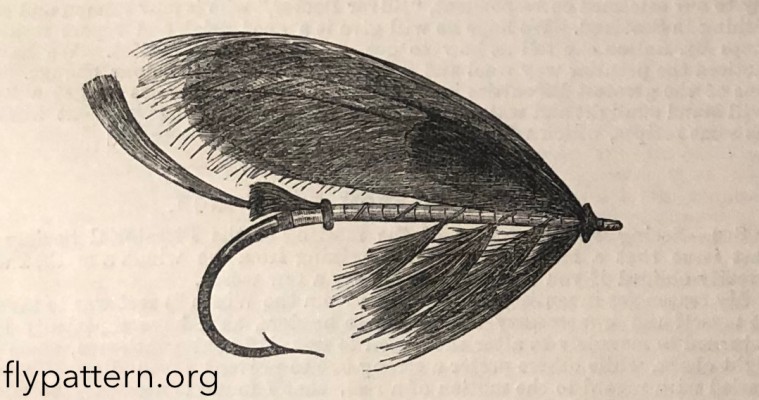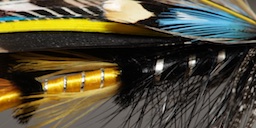| Author | Kelson, George M. |
| Book | The fishing gazette: On the description of salmon flies, Major Traherne's Patterns |
| Book Edition | N/A |
| From "The fishing gazette" - August 23rd, 1884 STEVENS' silicon tablet is a capital cure for tarnished tinsel; it not only revives, but preserves it from lacking lustre. It is sold at 103, Talbot-road, WV., in a little paper mache box which contains a brush for renovating timeworn "Lions," "MyQueens" &c., &c., and the piece of wash leather upon which the dry tablet should be rubbed serves for brightening and coating twists and tinsels ever so new, After removing a quarter of an inch of the silver at each end of the piece, apply the tweezers to the silk, pull it through the wash leather, which is held pretty firmly between the thumb and forefinger, up to, not beyond, the metal at the opposite end, reverse it, and repeat the dose. Ribs have a tendency to become loose on seals'-fur bodied flies, and if they are not made very firm at the head end, the fur, or some of it, will escape, and by degrees disappear. The tying-silk there, after the two first coils, ought to be placed between the third and fourth lingers of the left hand, and not stained; then give the tinsel a hard tug, taking hold of it with the pliers and pull the silk tight at the same time. For all practical purposes flat tinselled bodies can be run up by beginning at the throat, working to the butt and back again; but to make them particularly nice-regular and even as a piece of piping - a deal of preparatory arrangement is required . Some rig up a foundation with merely the tying silk waxed; but I consider the best plan is to utilise the floss in the inside of the tinsel as I suggested; and after the taper is formed of it, frayed out with the point of a needle and varnished, it should be made perfectly true and smooth before it is quite dry. Then you can make the ribs with the other end which has not been deprived of the silver coating, and as one turn of the tying-thread is all that is necessary close to the butt you prevent, instead of having to cure a lump there, which is so often made by the ordinary way of tying in the ribs. When this, or any similar system is supplemented, there need be but one layer of tinsel along the body, starting it at the butt. Before you fasten it there, out it from one of its sides to a point, and now, with the bevelled edge downwards, tie just that point in on the far side of the hook, leaving the least atom of it bare to turn back for clinching, under, and alongside. This should not occupy more room than half the width of the butt, which you can judge of by the illustration; the floss upon which you tie it will give way and bury that which would bulge, had you not left just that space (no more) unvarnished. Be careful not to put too much pressure on to the tying-silk, or you will imbed the tinsel too deep, which will leave a cavity and put you in another hobble. When the varnish over the taper is quite hard, the tinsel, which should have been held laterally, is wound along at a right angle, not askew; and the first turn of it disposes of the bevel. By winding it in this way, straight over the hook and pressing the coils close to each other with your nail as you proceed, the joints ought to be imperceptible. I say "held laterally;" the tinsel should be supported so while it is being tied on the far side of the hook , but it is important that the exact position of the rest of it should be mentioned in order to secure "a fair start." The hook should be so held that the shank is horizontal; the thumb and forefinger in squeezing it should be well bent, while the tinsel is resting straight along over the knuckles. If you hold the hook with the finger and thumb extended, you cannot advantageously make use of the middle linger, which gives much facility - not only that, you lose considerable power, as you cannot wind the tying-silk on the portion sheltered by the extremity of the fingers. The hackle maybe managed different ways; it is not only fixed tighter when pulled against the ribs, which also protect it from the teeth of the fish, but you can keep the shaft touching them the whole way when on that, the tag side. Nine dressers in everyten put it on the other; surely it is wrong to do so. A salmon pulls from you; therefore, if he tears the body of the fly, the gash is made from the head towards the tail, his teeth should, I suggest, wage war with the protecting tinsel first, which - unlike the feather - is capable of much resistance. Again, in coiling the hackle over the body, it is often cut asunder by the sharp tinsel at the starting point; that can be dodged by pressing the stiletto (the fine end) against the sharp edge, when you come to that turn in the tinsel, and the little curve you make in it by this means provides a safe outlet for the hackle. But my way, the ribbing can pass over the hackle just where it protrudes, and so when the latter is lifted to wind along the body, it butts immediately against the oval which prevents it from coming in contact with the sharp edge of the body tinsel and consequently, during the process you can pull it much harder with less danger. Accidents are pretty sure to happen; and it is tantalising to be compelled to take off and replace both tinsels, but if the hackle is injured or cut, there is no other remedy. That familiar phrase "To be continued in our next," may be quoted here, as I desire to refer to a slight error in my letter of last wee, from a facon de parler before touching upon the other topics. The feathers in the body of the "Don," as, perhaps, everyone knew, are from the neck of the jungle cock of India. "Jungle fowl," as I wrote, must not be confounded with it; the head and crest of this Australian bird is of a cinnamon brow, the neck is gray, and of little or no value to us. It is scarcely possible for us to mistake on neck feather for the other; the idea is too eccentric - one that may become practicable in the millennium, but certainly not before. The definition I gave, although inaccurate, would not lead any fly-dresser astray; but, perhaps, it should not remain uncorrected. The "May Queen" is another of these splendid specimens which serves to remind us what can be done by sheer perseverance. What a thing is patience! It sits and weaves so long in the gloom futilely till it fashions its own scientific reliable laws so strong as to sever the bonds of immemorial usage, and it traps at last. There is nothing in this sport in aftertime, however radiant with pleasure or success those latter times may be, so perfectly happy as the buoyant and fearless ignorance of the young fisherman just first thrust himeself from the shell of dependence, venturing alone into a salmon pool. He intuitively surveys with dazzled and delighted eyes the illimitable domain that lies in the mere Possible! He naturally expects any obstruction or impediments will give way before him, and for once he is triumphant. He never forgets this first stroke of luck - this first victory. As though accustomed to conquest, those memorable words, "Veni, Vidi, Vici," are engraven in his youthful and unworn mind where the fetter of tradition requires no loosening, nor the web of superstition no breaking. What a wonderful and supreme magician is Youth - but once only to be enjoyed, as it never returns. Pretty much the same deep sense and emotions affect the young fly tier in his uncertain and trepid attempts with his own early inventions - inventions which from close watchful attention may grow and claim their origin through some practical yet indescribable observation, and which therefore gradually inspire hime with instinctive confidence and hope. Fly-dressers need not necesssarily become fishermen, but all fishermen would benefit by becoming fly-dresssers; they would have a much better chance of bringing to good account the knowledge they are for ever cramming in from the facts brought to their notice in the constant whirl and incessant amusement of their life. The more their experience the more they find it difficult for any one impression to last long; in fact, they are almost sure to invent something in the way of flies more striking - more killing, until the living shape of their fancy has been summoned, as it were, into existence. Many years ago I remember the popular Scotch pattern which owned the time-honoured name of "The Maypole," constructed - or rather said to be so - after the colouring of the "Column of May," which once stood upon the site of the Church of St. Mary-le-Strand, and a fly from its posthumous fame probably receded into the shade much to soon; it would be interesting to know if a reliable sample is still in existence. Our illustration this week serves again to suggest that great artists narrow not themselves to one meagre phase of art; and with splendid plenitude it gives us a notion of their able powers. The fly may be described as follows: - Tag: Silver twist and silk, same shade as the point of the red crow. Tail: Topping, two red crow feathers (sideways). Butt: Black herl. Body: Blue silk, to end of first turn of ribs, same shade as the macaw hackle, the rest silver tinsel. Ribbed; Fine oval tinsel. Hackle: Powdered blue macaw (as illustrated). Throat: Yellow macaw. Wings: Two yellow macaw feathers. Cheeks: Enamelled thrush, two toppings over. Horns: Blue macaw. Head: Black herl. |
|
| Tags | traherne, kelson, fishinggazette, |
Material
- Tag: Silver twist and silk, same shade as the point of the red crow
- Tail: Topping, two red crow feathers (sideways)
- Butt: Black herl
- Body: Blue silk, to end of first turn of ribs, same shade as the macaw hackle, the rest silver tinsel
- Ribbed; Fine oval tinsel
- Hackle: Powdered blue macaw (as illustrated)
- Throat: Yellow macaw
- Wings: Two yellow macaw feathers
- Cheeks: Enamelled thrush, two toppings over
- Horns: Blue macaw
Head: Black herl

